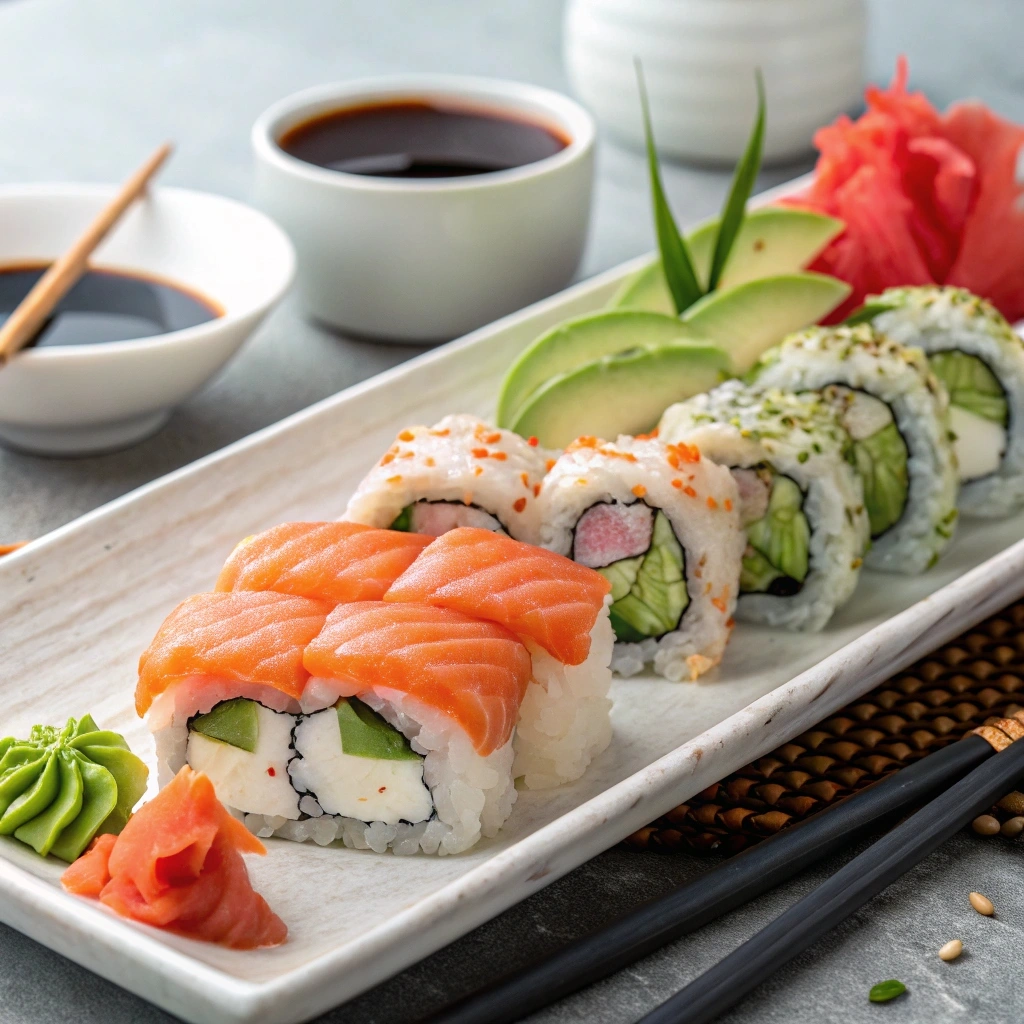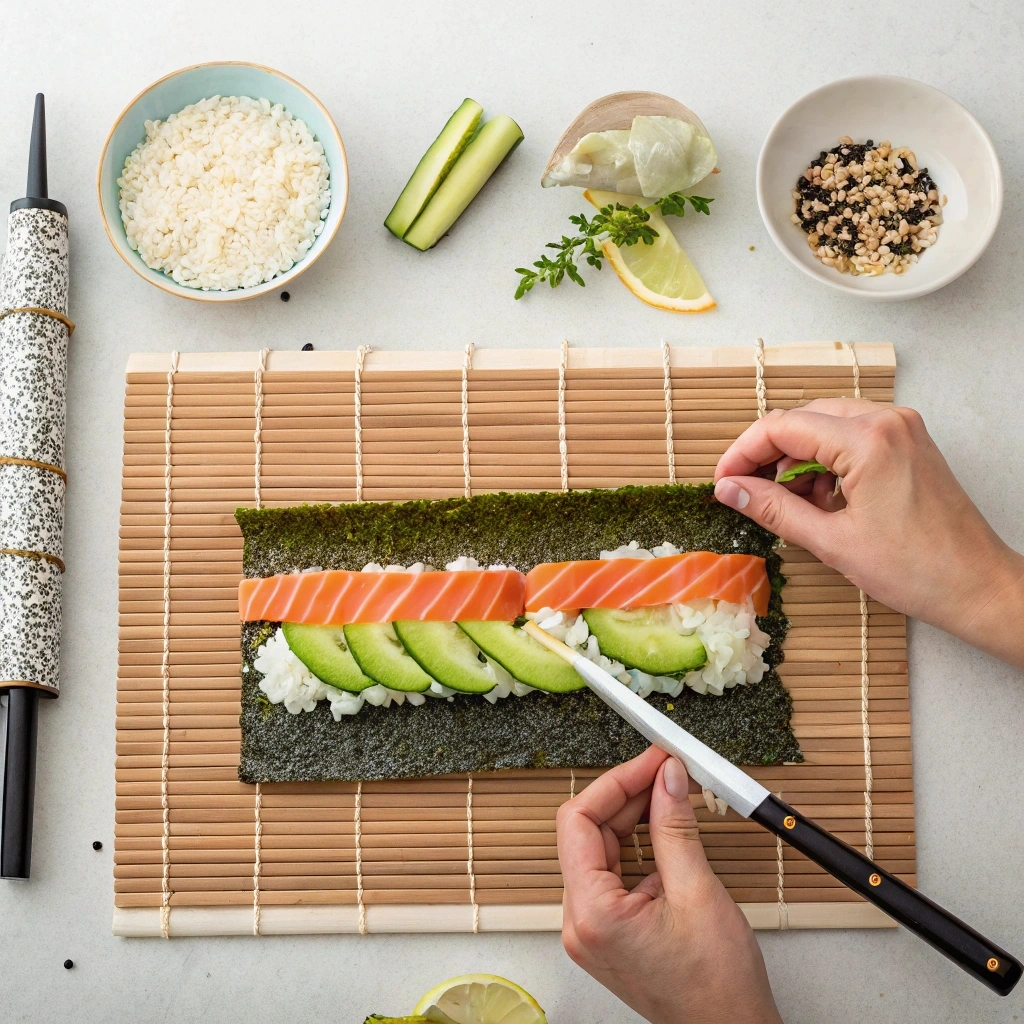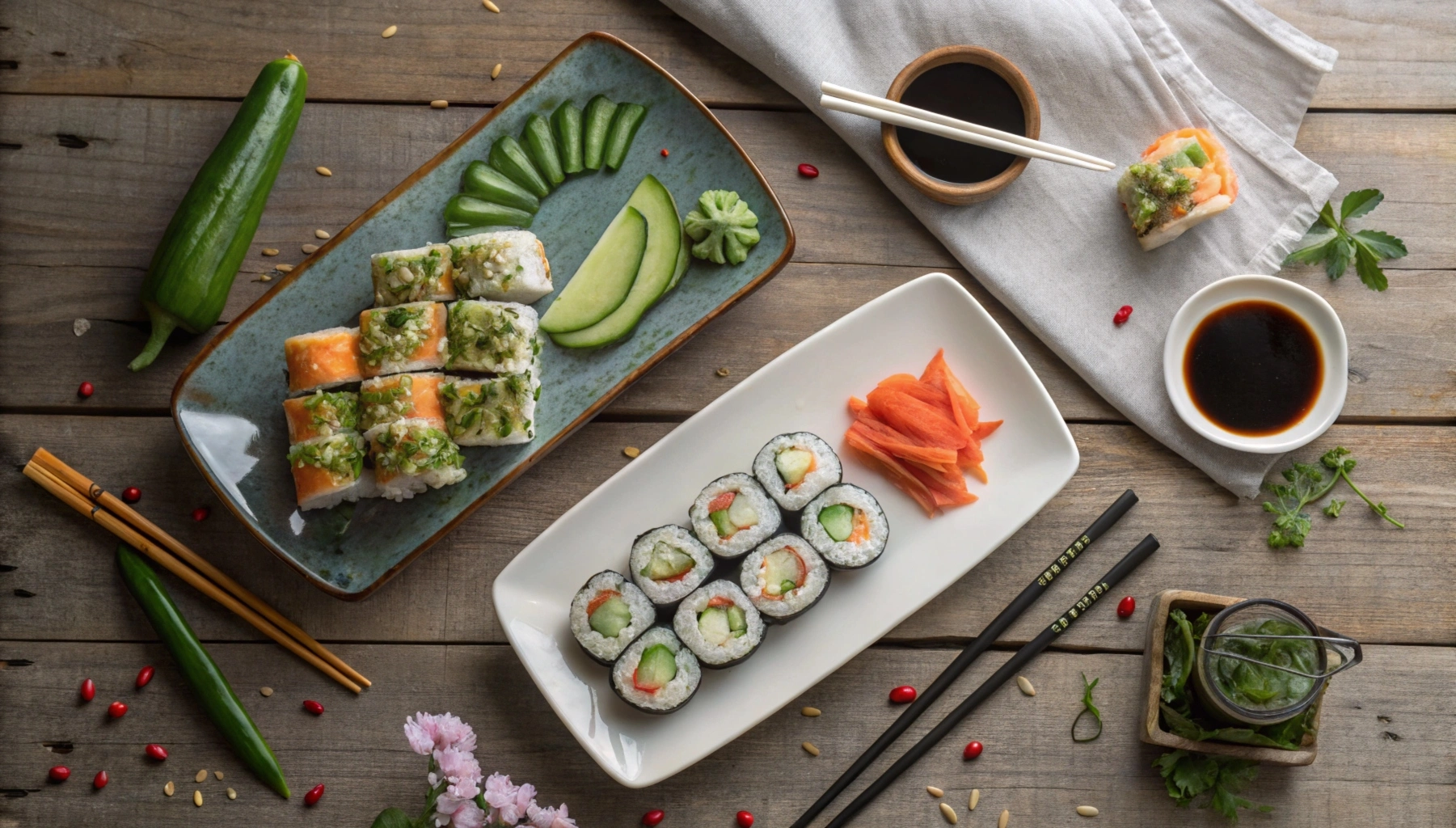Sushi provides an endless variety of flavorful options, each crafted with a meticulous balance of taste, texture, and visual appeal. Among the most iconic sushi rolls, the Philadelphia roll and the Alaskan roll have become standout favorites for sushi lovers around the world. Their popularity stems from their unique combination of ingredients and preparation methods, as well as their ability to appeal to different palates.
Both rolls are fusion creations, blending traditional Japanese techniques with Western influences. While they share some similarities, such as their creamy and savory elements, they differ significantly in their ingredients, textures, and overall flavor profiles. These differences make them appealing to a broad audience, whether one prefers the rich, indulgent taste of cream cheese or the fresh, vibrant flavor of salmon and crab.
So, what is the difference between a Philadelphia roll and an Alaskan roll? Understanding these differences requires a closer look at the composition, preparation, and presentation of each roll. This comprehensive guide will explore the key characteristics of both rolls and what makes each one a favorite among sushi enthusiasts.
For more inspiration, check out our guide to quick Dinner recipes
Introduction to the Rolls
What Is a Philadelphia Roll?
The Philadelphia roll, often referred to as the “Philly roll,” is a classic example of fusion-style sushi that marries Japanese tradition with Western flavors. This roll stands out for its use of cream cheese, an unconventional ingredient in traditional sushi, which adds a luxurious, creamy texture. The combination of ingredients creates a well-balanced flavor profile that has become a favorite for sushi lovers around the world.
The key ingredients in a Philadelphia roll include:
- Smoked Salmon: Known for its bold, smoky taste, smoked salmon serves as the main protein. It offers a fully cooked option for those who prefer sushi without raw fish, making the roll more accessible to a wider audience.
- Cream Cheese: This is the defining ingredient of the Philadelphia roll. Its rich, tangy flavor and smooth texture pair beautifully with the salmon, adding a Western twist to the roll.
- Cucumber: Fresh, crisp cucumber is included to provide a crunchy contrast to the cream cheese and smoked salmon. It helps balance the richness of the roll with its refreshing taste.
- Nori (Seaweed) and Sushi Rice: These foundational elements are essential to all sushi rolls. The nori binds the ingredients together, while the vinegared sushi rice adds a slightly tangy flavor that complements the other components.
Some variations of the Philadelphia roll may include avocado or scallions, adding additional creaminess or a subtle onion-like flavor. These variations enhance the roll’s versatility and appeal.
The Philadelphia roll is perfect for those who enjoy the fusion of creamy, smoky, and refreshing elements, making it a crowd-pleaser for both sushi enthusiasts and newcomers.
What Is an Alaskan Roll?
The Alaskan roll is another popular fusion sushi creation, celebrated for its fresh, vibrant flavors and its eye-catching presentation. This roll showcases salmon as its star ingredient, often used as a topping, which makes it as visually appealing as it is delicious. Unlike the Philadelphia roll, the Alaskan roll focuses more on fresh, clean flavors, creating a lighter, seafood-centric experience.
The primary ingredients in an Alaskan roll include:
- Crab Meat: Typically made with imitation crab (kani), but some versions use real crab for a more luxurious touch. The crab adds a sweet, delicate flavor that contrasts beautifully with the other components.
- Avocado: Creamy avocado enhances the roll’s richness, complementing the seafood while providing healthy fats.
- Cucumber: Adds a crisp texture and refreshing taste, balancing the creaminess of the avocado and the richness of the salmon.
- Nori (Seaweed) and Sushi Rice: As with any sushi roll, these foundational elements provide structure and a neutral base for the flavors to shine.
- Salmon Topping: Fresh, smoked, or lightly seared salmon serves as the roll’s signature ingredient. It not only enhances the flavor profile but also creates a visually striking presentation that makes the Alaskan roll a favorite in sushi restaurants.
Some variations of the Alaskan roll might include spicy mayo, sesame seeds, or tobiko (fish roe) for added flavor and texture. These additions further elevate the roll, making it a versatile choice for sushi enthusiasts.
The Alaskan roll is ideal for those who prefer lighter, fresher sushi flavors with a focus on high-quality seafood. It’s a perfect choice for anyone looking to experience the natural taste of salmon and crab, enhanced by creamy avocado and crisp cucumber.
Comparing the Two
While both rolls are fusion-style creations, the Philadelphia roll leans toward indulgence with its rich, creamy texture and smoky flavor, making it ideal for those who enjoy more decadent sushi options. The Alaskan roll, on the other hand, is a lighter, fresher alternative that emphasizes vibrant, clean flavors and the natural taste of seafood. Both are unique in their own way, catering to a variety of palates and preferences.
The Key Differences Between a Philadelphia Roll and an Alaskan Roll
Now that we have introduced the basics, let us explore how these rolls differ in their core components, flavor profiles, and presentation.
1. Core Ingredients
- Philadelphia Roll: This roll is defined by its use of cream cheese and smoked salmon. These two ingredients, combined with cucumber, create a rich, creamy texture.
- Alaskan Roll: On the other hand, the Alaskan roll emphasizes fresh or smoked salmon as a topping. Inside, it contains crab meat, avocado, and cucumber, making it a lighter option overall.
2. Flavor Profiles
- Philadelphia Roll: The Philly roll has a creamy and smoky flavor profile, reminiscent of a bagel with lox. Because of the cream cheese, it feels heavier and more indulgent.
- Alaskan Roll: In contrast, the Alaskan roll focuses on fresh, clean flavors. The crab, cucumber, and avocado balance the richness of the salmon topping.
3. Toppings
- Philadelphia Roll: This roll is typically plain on the outside, with all its ingredients inside. There is little to no focus on external garnishes.
- Alaskan Roll: Meanwhile, the Alaskan roll features a layer of salmon on top, often garnished with sesame seeds, scallions, or a drizzle of sauce.
4. Texture
- Philadelphia Roll: The texture of the Philly roll is smooth and creamy due to the cream cheese, with a slight crunch from the cucumber.
- Alaskan Roll: The Alaskan roll has a more dynamic texture, combining the softness of salmon and avocado with the crunchiness of cucumber.
5. Presentation
- Philadelphia Roll: This roll is simpler in presentation and does not usually have elaborate plating.
- Alaskan Roll: In contrast, the Alaskan roll’s salmon topping and garnishes make it visually striking and more elegant.

Step-by-Step Guide to Making the Rolls
How to Make a Philadelphia Roll
To make a Philadelphia roll, follow these steps:
- Prepare the Ingredients
- Slice smoked salmon into thin strips.
- Cut cream cheese into long, thin pieces to make rolling easier.
- Slice cucumber into matchstick-sized pieces.
- Assemble the Roll
- Place a sheet of nori on a bamboo sushi mat.
- Spread an even layer of sushi rice over the nori, leaving an inch at the top.
- Add cream cheese, smoked salmon, and cucumber along the center.
- Roll the Sushi
- Tightly roll the sushi using the bamboo mat to shape it.
- Seal the edge with a small amount of water.
- Slice and Serve
- Dip a sharp knife in water and cut the roll into even pieces.
- Serve alongside soy sauce, wasabi, and pickled ginger for dipping.
How to Make an Alaskan Roll
For the Alaskan roll, follow these steps:
- Prepare the Ingredients
- Slice salmon into thin pieces for the topping.
- Shred or portion the crab meat and cut the avocado and cucumber into thin strips.
- Assemble the Roll
- Evenly spread the sushi rice across the nori sheet.
- Add crab meat, avocado, and cucumber along the center.
- Roll the Sushi
- Carefully roll the sushi using the bamboo mat to form a tight roll.
- Seal the nori with a touch of water.
- Add the Salmon Topping
- Cover the roll with salmon slices, ensuring the entire surface is filled.
- Press gently to secure the salmon.
- Slice and Garnish
- Cut the roll into pieces using a knife dipped in water.
- Top with sesame seeds, sliced scallions, or a drizzle of sauce for garnish.

Frequently Asked Questions (FAQ)
What Is the Difference Between a Philadelphia Roll and an Alaskan Roll?
The Philadelphia roll and the Alaskan roll are both popular sushi options, but they have distinct differences in their ingredients and flavors:
- Philadelphia Roll: This roll is defined by its use of smoked salmon and cream cheese, creating a rich, creamy texture and a smoky flavor. It often includes cucumber or avocado for added crunch and creaminess.
- Alaskan Roll: The Alaskan roll typically features crab (often imitation crab), avocado, cucumber, and a topping of salmon. The salmon can be fresh (raw), smoked, or seared, depending on the preparation. Unlike the Philadelphia roll, the Alaskan roll does not include cream cheese, making it lighter and more focused on the freshness of the seafood.
Does the Philadelphia Roll Have Raw Fish?
No, the Philadelphia roll traditionally uses smoked salmon, which is fully cooked. This makes it a great option for people who enjoy sushi but prefer to avoid raw fish. The smoked salmon also provides a distinct smoky flavor that pairs beautifully with the creamy texture of the cream cheese. However, some variations might include raw salmon, so it’s always best to confirm with your sushi chef or restaurant.
Is the Salmon in an Alaskan Roll Raw?
The salmon in an Alaskan roll can vary based on preparation methods and personal preferences:
- Raw Salmon: The most common option, raw salmon highlights the fish’s freshness and buttery texture.
- Smoked Salmon: This alternative adds a savory, smoky depth to the roll.
- Seared Salmon: Lightly seared salmon brings a caramelized, crisp outer layer while maintaining a tender interior.
Each preparation style offers a unique flavor experience, so it depends on your personal taste and the chef’s expertise.
Which Roll Is Healthier?
When comparing the two, the Alaskan roll is generally considered the healthier choice for several reasons:
The smoked salmon contributes protein and omega-3s but is slightly higher in sodium compared to raw salmon.
Alaskan Roll:
Lower in calories since it lacks cream cheese.
Rich in omega-3 fatty acids from the salmon and crab.
Includes fresh vegetables like cucumber and avocado, which provide fiber, vitamins, and healthy fats.
Philadelphia Roll:
Higher in calories and fat due to the cream cheese.
While still nutritious, the cream cheese adds a more indulgent quality, making it heavier than the Alaskan roll.
Conclusion
In conclusion, the Philadelphia roll and Alaskan roll each provide a distinct sushi experience, catering to a variety of tastes and preferences. The Philadelphia roll is perfect for those who enjoy a rich, creamy texture combined with the smoky flavor of cooked salmon, making it a comforting and indulgent choice. On the other hand, the Alaskan roll offers a lighter and fresher profile, with its combination of crab, avocado, cucumber, and salmon that highlights the natural flavors of seafood.
Understanding the differences between these rolls allows you to select the one that best suits your palate or occasion. Whether you’re drawn to the creamy decadence of cream cheese or the bright and vibrant notes of fresh or smoked salmon, both rolls showcase the incredible versatility and creativity of sushi-making. Whichever you choose, you’re sure to enjoy a flavorful and satisfying meal.

